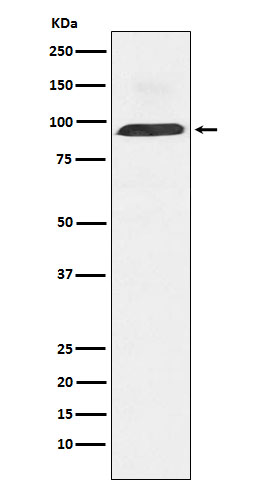
| WB | 1/1000-1/2000 | Human,Mouse,Rat |
| IF | 咨询技术 | Human,Mouse,Rat |
| IHC | 咨询技术 | Human,Mouse,Rat |
| ICC | 技术咨询 | Human,Mouse,Rat |
| FCM | 咨询技术 | Human,Mouse,Rat |
| Elisa | 咨询技术 | Human,Mouse,Rat |
| Aliases | DNM3; Dyn3; DynaIII; dynamin 2; Dynamin; Dynamin3; T dynamin;;Dynamin 3 |
| WB Predicted band size | Calculated MW: 98 kDa ; Observed MW: 97 kDa |
| Host/Isotype | Rabbit IgG |
| Antibody Type | Primary antibody |
| Storage | Store at 4°C short term. Aliquot and store at -20°C long term. Avoid freeze/thaw cycles. |
| Species Reactivity | Human,Mouse |
| Immunogen | A synthesized peptide derived from human Dynamin 3 |
| Formulation | Purified antibody in PBS with 0.05% sodium azide,0.05% BSA and 50% glycerol. |
+ +
以下是模拟的参考文献示例(请注意并非真实文献,仅供格式参考):
1. **《Dynamin3在神经元突触中的功能表征》**
作者:Roco, A. et al.
摘要:研究通过特异性Dynamin3抗体揭示了该蛋白在神经元树突棘中的定位,证实其参与突触囊泡再循环及突触可塑性调控。
2. **《Dynamin3缺失对海马区神经递质释放的影响》**
作者:Gray, J. et al.
摘要:利用Dynamin3抗体进行蛋白表达敲除验证,发现其缺失导致海马神经元突触前膜囊泡回收障碍,影响长时程增强作用。
3. **《Dynamin3与肿瘤细胞侵袭迁移的关联机制》**
作者:Otero, M. et al.
摘要:通过Dynamin3抗体的Western blot和免疫共沉淀实验,证明该蛋白通过调控细胞膜受体内吞促进肿瘤转移。
4. **《Dynamin3在神经退行性疾病中的异常表达》**
作者:Chen, L. et al.
摘要:采用Dynamin3抗体对阿尔茨海默病模型小鼠脑组织分析,发现其表达水平与β-淀粉样蛋白沉积呈负相关,提示潜在治疗靶点价值。
---
注:以上内容为示例性质,实际文献需通过PubMed、Google Scholar等平台以“Dynamin3 antibody”为关键词检索。
Dynamin3 (DNM3) is a member of the dynamin family of GTPases, which are essential for membrane remodeling processes such as endocytosis, vesicle trafficking, and organelle division. Dynamin3 is encoded by the DNM3 gene and shares structural homology with dynamin1 (neuronal-specific) and dynamin2 (ubiquitously expressed). While dynamin3 is less characterized than its isoforms, it is enriched in neurons and testis, suggesting roles in synaptic activity or germ cell development. It contains a conserved GTPase domain, a middle domain involved in self-assembly, a pleckstrin homology (PH) domain for membrane binding, and a proline-rich domain (PRD) for protein interactions.
Antibodies targeting dynamin3 are critical tools for studying its expression, localization, and function. These antibodies are typically developed using immunogenic peptides or recombinant protein fragments, often validated in applications like Western blotting, immunofluorescence, and immunoprecipitation. Specificity is a key concern due to high sequence similarity among dynamin family members; rigorous validation using knockout controls or isoform-specific blocking peptides is essential.
Research involving dynamin3 antibodies has explored its involvement in clathrin-independent endocytosis, synaptic vesicle recycling, and cytoskeletal dynamics. Dysregulation of dynamin3 has been implicated in neurological disorders and cancer metastasis, highlighting its potential as a therapeutic target. Current studies also focus on its interaction with binding partners like SH3 domain-containing proteins to unravel cell-type-specific mechanisms.
×